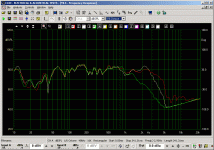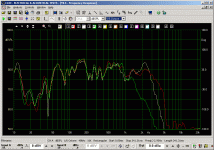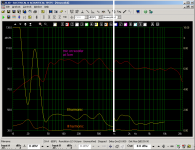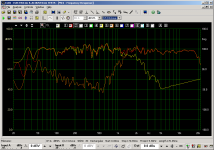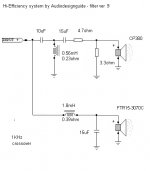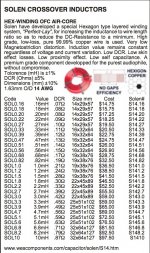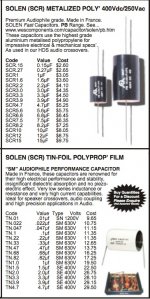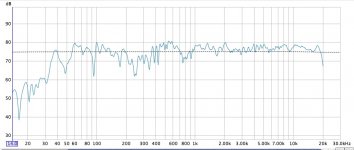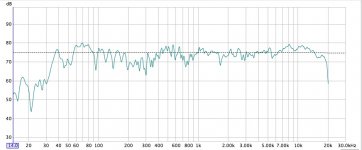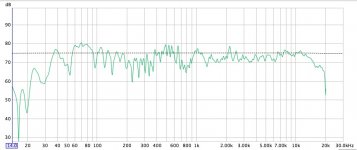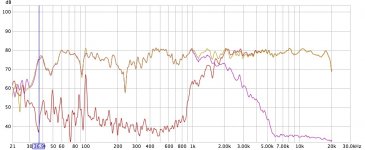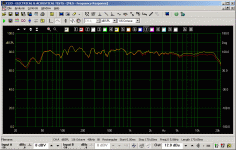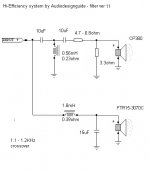apelizzo,
Here the frequency response of the woofer without any filter (red), with my 1KHz (green) and with your at 2.5Khz (white).
mic distance 2meters and height 90cm.
All these 3 plot are equal until 1KHz and only the cut-off is different.
So probably your measurements are in different conditions.
There are 2 image for 2 different resolutions.
Here the frequency response of the woofer without any filter (red), with my 1KHz (green) and with your at 2.5Khz (white).
mic distance 2meters and height 90cm.
All these 3 plot are equal until 1KHz and only the cut-off is different.
So probably your measurements are in different conditions.
There are 2 image for 2 different resolutions.
Attachments
I don't worry about the inperceptable, insignificant or the irrelavent, so I guess that I don't know the answer.
This answer must be from the gedlee marketing department, a company selling a speaker using a 1" compression driver crossed over somewhere around 700-800hz. But we know how speaker marketing is. Like you have said many times in the past, "they never tell you the truth about their speakers. They don't show you the important data"
I would be glad to have gedlee the scientist back to this discussion.
I would be glad to have gedlee the scientist back to this discussion.
Then don't insult him.
to eliminate any doubt about the validity of the cut-off at 1KHz I am sending you the plot showing the distorting of both drivers in the near field (5-10cm).
We can note that at 1KHz the driver CP380 remain at around 1.5% as the woofer.
So with regards to CP380 distortion at 1K I was right: at 2.5K is half. I think ears are more sensitive with 1.5% distortion on mid-high then 1.5% on mid-bass. Perhaps it doesn't mean enything.
Of course other aspects of the speaker system are probably more relevant that overrides distortion objections. In fact I can hear the female voice more clear at 1KHz xover point. Male voice so so.
Last edited:
apelizzo,
Here the frequency response of the woofer without any filter (red), with my 1KHz (green) and with your at 2.5Khz (white).
mic distance 2meters and height 90cm.
All these 3 plot are equal until 1KHz and only the cut-off is different.
So probably your measurements are in different conditions.
There are 2 image for 2 different resolutions.
I've done some tests and I agree with you with regards to the directivity of the woofer at 2.5K. Also that nasty 2KHz peak needs to be chopped off with parallel eq filter. That peak is exactly how the crossover simulator predicted.
Are you considering of making the horn frequency response more flat or you leave the natural roll off slope from 2k to 10K (~4-5dB).
Do you feel some details missing?
Last edited:
apelizzo,
for me this is only a starting point, I have ordered some SCR and some Solen to make other tests.
I consider good only SCR and Solen in the loudspeakers crossover.
The experiences with Audyn cap and Mundorf are terrible.
Audyn cap Plus are better than normal but never good as Solen or Scr.
Which type are you using ?
For the inductane I am using the Intertechnik 1.4mm
Lautsprecher Shop Intertechnik - CU 1.40mm :: Inductors :: Cross-over electronic parts ::
Now I have found this new filter but I need to wait the Scr and Solen caps to test the sound.
for me this is only a starting point, I have ordered some SCR and some Solen to make other tests.
I consider good only SCR and Solen in the loudspeakers crossover.
The experiences with Audyn cap and Mundorf are terrible.
Audyn cap Plus are better than normal but never good as Solen or Scr.
Which type are you using ?
For the inductane I am using the Intertechnik 1.4mm
Lautsprecher Shop Intertechnik - CU 1.40mm :: Inductors :: Cross-over electronic parts ::
Now I have found this new filter but I need to wait the Scr and Solen caps to test the sound.
Attachments
apelizzo,
for me this is only a starting point, I have ordered some SCR and some Solen to make other tests.
I consider good only SCR and Solen in the loudspeakers crossover.
The experiences with Audyn cap and Mundorf are terrible.
Audyn cap Plus are better than normal but never good as Solen or Scr.
Which type are you using ?
For the inductane I am using the Intertechnik 1.4mm
Lautsprecher Shop Intertechnik - CU 1.40mm :: Inductors :: Cross-over electronic parts ::
Now I have found this new filter but I need to wait the Scr and Solen caps to test the sound.
I can see is getting more flat. Looking good! Decreasing 30uF to 10 and less L-pad = more top
I normally use Solen caps. I will try these Solen inductors both from local supplier. (reseller prices in AU$)
Attachments
Last edited:
New crossover. Response 1/12 on axis and 30 degrees and 45 degrees
I'm happy with the DDS dispersion pattern.
My DDS and Stereolab have different freq response so I modified the Audiodesign xover
I'm happy with the DDS dispersion pattern.
My DDS and Stereolab have different freq response so I modified the Audiodesign xover
Attachments
Last edited:
Crossover frequency ?
Sound result ?
I don't like my DDS at 1K starts sounding "cha cha" so I compromised your design but not excessive as before at 2.5K. The woofer is not so much directional as before and almost unnoticed. I think this is a good balance for now.
I changed a couple of values in your design. 10uF is now 3.9uF the 4.7R is now 10R and the 1.8mH is 1.64mH. All the rest is the same. It's still under experiment.
The sound is better then before and the sound stage is huge and deeper then at 1K xover point. With one speaker the sound stage is already there and the speaker tend to disappear (horn 80%). With two the horn also disappears 100%
At crossover point the phases are opposite according to measurements so the horn has polarity inverted.
So far I'm happy. Still trying to get a little lower with the horn before start sounding bad.
Attachments
Last edited:
new filter, tested with all Scr caps.
Nice work

The horn measures extreme flat very good Andrea. I bet it sounds very smooth together with the low distortion of the horn driver.
Last edited:
Different path
Having previously experimented on single driver speaker, I give up on the passive crossover on this system. Passive crossovers never reach good performance due to dynamic phase shift and damage all good work done by expensive SE output transformers.
I just don't like this kind of approach.
So I started a new research on Bi-amp. By the time you buy expensive inductors and capacitors for all sort of tests I already built a second amplifier and got better performance.
Because the horn is very sensitive to minor alterations on frequency response linearity I aim to improve the part of 1KHz to 2KHz (also down to 500Hz) which I can see in Audiodesign measurement is still up and down. Doing that with small signal is easier. Also as I mentioned above I aim to reduce to minimum the phase distortion.
Having previously experimented on single driver speaker, I give up on the passive crossover on this system. Passive crossovers never reach good performance due to dynamic phase shift and damage all good work done by expensive SE output transformers.
I just don't like this kind of approach.
So I started a new research on Bi-amp. By the time you buy expensive inductors and capacitors for all sort of tests I already built a second amplifier and got better performance.
Because the horn is very sensitive to minor alterations on frequency response linearity I aim to improve the part of 1KHz to 2KHz (also down to 500Hz) which I can see in Audiodesign measurement is still up and down. Doing that with small signal is easier. Also as I mentioned above I aim to reduce to minimum the phase distortion.
Last edited:
Having previously experimented on single driver speaker, I give up on the passive crossover on this system. Passive crossovers never reach good performance due to dynamic phase shift and damage all good work done by expensive SE output transformers.
Excuse me, but I only use passive crossovers because the best active can do is equal a passive at a much higher cost. This is not good engineering.
Excuse me, but I only use passive crossovers because the best active can do is equal a passive at a much higher cost. This is not good engineering.
What you are saying is too generic so I disagree. It depends on what is the "active crossover" in the system.
Last edited:
 This is opinion, not fact. It should be clearly labeled as such.
This is opinion, not fact. It should be clearly labeled as such.(But thank you for including "I just don't like this kind of approach.")Passive crossovers never reach good performance due to dynamic phase shift and damage all good work done by expensive SE output transformers..
Also opinion until proved otherwise....the best active can do is equal a passive at a much higher cost.
This is opinion, not fact. It should be clearly labeled as such.
(But thank you for including "I just don't like this kind of approach.")
My apologies, I tried to express "ÏMO" with "I just don't like this kind of approach."
How about "This is not good engineering." from gedlee ??
I also apologize for drifting out of the scope of this thread. I will not bring any further comment here.
Goodbye
Last edited:
- Home
- Loudspeakers
- Multi-Way
- Hi-End and Hi-Efficency loudspeakers (horn + onken)
